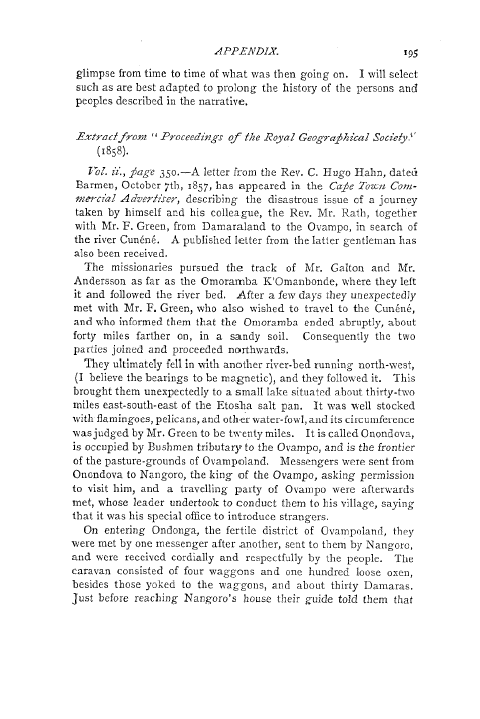APPENDIX.
195
glimpse from time to time of what was then going on. I will select such as are best adapted to prolong the history of the persons and peoples described in the narrative.
Extractfrom "Proceedings of the Royal Geographical Society." (1858).
Z`ol. ii., j5age 35o.-A letter from the Rev. C. Hugo Hahn, dated Farmer, October 7th, 1857, has appeared in the Cape Ti en Commercial Advertiser, describing the disastrous issue of a journey taken by himself and his colleague, the Rev. Mr. Rath, together with Mr. F. Green, from Damaraland to the Ovampo, in search of the river Cunfne. A published letter from the latter gentleman has also been received.
The missionaries pursued the track of Mr. Gallon and Mr. Andersson as far as the Omoramba K'Omanbonde, where they left it and followed the river bed. After a few days they unexpectedly met with Mr. F. Green, who also wished to travel to the Cunene, and who informed them that the Omoramba ended abruptly, about forty miles farther on, in a sandy soil. Consequently the two parties joined and proceeded northwards.
They ultimately fell in with another river-bed running north-west, (I believe the bearings to be magnetic), and they followed it. This brought them unexpectedly to a small lake situated about thirty-two miles east-south-east of the Etosha salt pan. It was well stocked with flamingoes, pelicans, and other water-fowl, and its circumference was judged by Mr. Green to be twenty miles. It is called Onondova, is occupied by Bushmen tributary to the Ovampo, and is the frontier of the pasture-grounds of Ovampoland. Messengers were sent from Onondova to Nangoro, the king of the Ovampo, asking permission to visit him, and a travelling party of Ovampo were afterwards met, whose leader undertook to conduct them to his village, saying that it was his special office to introduce strangers.
On entering Ondonga, the fertile district of Ovampoland, they were met by one messenger after another, sent to them by Nangoro, and were received cordially and respectfully by the people. The caravan consisted of four waggons and one hundred loose oxen, besides those yoked to the waggons, and about thirty Damaras. Just before reaching Nangoro's house their guide told them that

